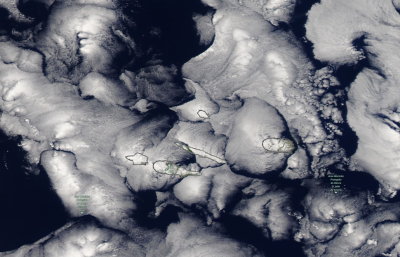Cloud Response to Aerosol Confounded by its Effectiveness to Hold Water
The human-generated impacts of aerosol particles on the brightness of clouds, known as cloud albedo, continue to be highly uncertain. This uncertainty, which applies particularly to low-level marine liquid clouds, contributes to a large portion of the uncertainty in global temperature predictions by climate models. An increase in the number of aerosol particles that serve as cloud droplet nucleators inherently increases the cloud droplet concentration (Nd) while reducing cloud droplet size, which brightens the cloud and creates a cooling effect on the climate known as the Twomey effect. Additional cloud properties affecting albedo including cloud liquid water path (LWP) and cloud areal coverage also adjust to changes in cloud droplet number. These adjustments combine with the Twomey effect to determine the overall cloud albedo change in response to a change in aerosols, referred to as the cloud albedo susceptibility. Accurately simulating cloud albedo susceptibility is critical to predicting global temperatures in the future, and thus, observations of this susceptibility that can be used to evaluate climate models are also critical. However, models also need to predict the correct answer for the correct reasons and understand reasons for discrepancies with observations, which means that it is also necessary to decompose susceptibility into key processes that control it and evaluate how well they are represented in models.
In this study, five years of ground-based and satellite observations at the Department of Energy (DOE) Atmospheric Radiation Measurement Eastern North Atlantic site were used to evaluate marine liquid cloud albedo susceptibility to aerosols in DOE’s Energy Exascale Earth System Model (E3SMv1). Simulated cloud albedo susceptibility is slightly weaker than observed with two factors contributing to its suppression. First, E3SMv1 has a Nd seasonal cycle that correlates with the sun angle, a correlation that is not observed. Second, clouds contain much less water relative to their water-holding capacity in E3SMv1 than what is observed. This relation between a cloud’s water amount and its water-holding potential is called cloud adiabaticity. Removing these seasonality and cloud adiabaticity differences between E3SMv1 and observations that mask the response of clouds to aerosols produces a greater cloud-brightening effect by aerosols in E3SMv1. This excessive brightening is primarily attributable to a greater Twomey effect caused by a stronger response of Nd to changes in cloud nucleating aerosols. Relative to observations, lesser cloud adiabaticity in E3SMv1 is correlated with more frequent rain and weaker inversions that support deeper clouds and potentially greater evaporation of clouds by mixing dry air. Comparison of observed and simulated LWP responses to aerosols varies considerably depending on the choice of dataset. Despite being similar in magnitude to the Twomey effect, it fails to counter it in the overall cloud radiative susceptibility, suggesting the common method used in this study for estimating the LWP response to Nd is not an accurate representation of the true response. More research is required to find techniques that can accurately quantify cloud LWP and areal coverage adjustments to changes in Nd.
The results of this study highlight the usefulness of aerosol-cloud interaction diagnostics to illuminate climate-model components requiring improvement. The study also highlights a need for more investigation into and development of parameterizations affecting aerosol activation, drizzle formation and growth, and cloud entrainment processes. In the future, additional attention needs to be paid to processes that affect the evolution of inversion strength, notably boundary layer deepening.
These results also show that work is required to improve observational retrievals of aerosol and cloud properties that constrain aerosol-cloud interactions, notably cloud droplet number, while improved techniques are required to quantify cloud adjustments to aerosol perturbations. In the short-term absence of retrieval advances, the comparison of any single observational and model dataset can be misleading. Multiple observational perspectives, usage of both direct and simulator output from models, and consideration of assumptions used in retrievals reduce the chances of misinterpreting model-observation comparisons, the danger of which is misguided model modifications that hamper predictions.
Aerosol-cloud process-oriented diagnostics such as those used in this study continue to be developed and implemented into the Earth System Model Aerosol-Cloud Diagnostics (ESMAC-Diags) open-source software with an eye toward new high-resolution model output in which processes can be better assessed and linked to measurements than ever before, a key step toward physically constrained and guided E3SM improvement.
Well-defined diagnostics are required for consistent model evaluation that guides climate model prediction improvements. Traditional diagnostics cover large scales that are critical but are separated from fine-scale processes such as aerosol-cloud interactions that substantially contribute to global climate prediction uncertainty. Thus, it is important to have additional finer-scale process-oriented diagnostics that complement traditional metrics. These diagnostics promote improving climate models via a more accurate representation of physical processes rather than ad hoc tuning.
Our study focused on developing metrics that decompose process contributions to marine low-cloud albedo susceptibility, which modulates the highly uncertain but climate-critical effective radiative forcing due to aerosol-cloud interactions. This necessitated the usage of detailed measurements at a long-standing DOE observing site. We found that differences in observed and simulated cloud properties heavily modulated the cloud-brightening response to aerosols. After sorting through these differences, it was found that E3SMv1 clouds brighten too much in response to aerosols because the number of cloud droplets increases too quickly with the number of aerosols. This result, coupled with cloud property model-observation differences that suppress the brightening effect in E3SMv1 relative to observations, points to aerosol activation, drizzle formation and growth, cloud top mixing, and boundary layer growth as areas to focus further investigation for the purposes of improving aerosol-cloud interaction effects on the climate. Diagnostics developed in this study have been implemented into open-source software for continued use as E3SM continues to evolve and move toward higher resolution.

